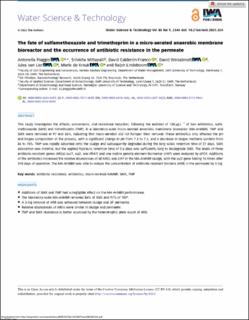| dc.contributor.author | Piaggio, Antonella | |
| dc.contributor.author | Mittapalli, Srilekha | |
| dc.contributor.author | Calderón-Franco, David | |
| dc.contributor.author | Weissbrodt, David | |
| dc.contributor.author | van Lier, Jules | |
| dc.contributor.author | de Kreuk, Merle | |
| dc.contributor.author | Lindeboom, Ralph | |
| dc.date.accessioned | 2024-03-14T06:45:06Z | |
| dc.date.available | 2024-03-14T06:45:06Z | |
| dc.date.created | 2023-10-20T19:33:31Z | |
| dc.date.issued | 2023 | |
| dc.identifier.citation | Water Science and Technology. 2023, 88 (9), 2344-2363. | en_US |
| dc.identifier.issn | 0273-1223 | |
| dc.identifier.uri | https://hdl.handle.net/11250/3122253 | |
| dc.description.abstract | This study investigates the effects, conversions, and resistance induction, following the addition of 150 μg·L−1 of two antibiotics, sulfamethoxazole (SMX) and trimethoprim (TMP), in a laboratory-scale micro-aerated anaerobic membrane bioreactor (MA-AnMBR). TMP and SMX were removed at 97 and 86%, indicating that micro-aeration did not hamper their removal. These antibiotics only affected the pH and biogas composition of the process, with a significant change in pH from 7.8 to 7.5, and a decrease in biogas methane content from 84 to 78%. TMP was rapidly adsorbed onto the sludge and subsequently degraded during the long solids retention time of 27 days. SMX adsorption was minimal, but the applied hydraulic retention time of 2.6 days was sufficiently long to biodegrade SMX. The levels of three antibiotic-resistant genes (ARGs) (sul1, sul2, and dfrA1) and one mobile genetic element biomarker (intI1) were analyzed by qPCR. Additions of the antibiotics increased the relative abundances of all ARGs and intI1 in the MA-AnMBR sludge, with the sul2 gene folding 15 times after 310 days of operation. The MA-AnMBR was able to reduce the concentration of antibiotic-resistant bacteria (ARB) in the permeate by 3 log. | en_US |
| dc.language.iso | eng | en_US |
| dc.publisher | IWA Publishing | en_US |
| dc.rights | Navngivelse 4.0 Internasjonal | * |
| dc.rights.uri | http://creativecommons.org/licenses/by/4.0/deed.no | * |
| dc.title | The fate of sulfamethoxazole and trimethoprim in a micro-aerated anaerobic membrane bioreactor and the occurrence of antibiotic resistance in the permeate | en_US |
| dc.title.alternative | The fate of sulfamethoxazole and trimethoprim in a micro-aerated anaerobic membrane bioreactor and the occurrence of antibiotic resistance in the permeate | en_US |
| dc.type | Peer reviewed | en_US |
| dc.type | Journal article | en_US |
| dc.description.version | publishedVersion | en_US |
| dc.source.pagenumber | 2344-2363 | en_US |
| dc.source.volume | 88 | en_US |
| dc.source.journal | Water Science and Technology | en_US |
| dc.source.issue | 9 | en_US |
| dc.identifier.doi | 10.2166/wst.2023.324 | |
| dc.identifier.cristin | 2186994 | |
| cristin.ispublished | true | |
| cristin.fulltext | original | |
| cristin.qualitycode | 1 | |

